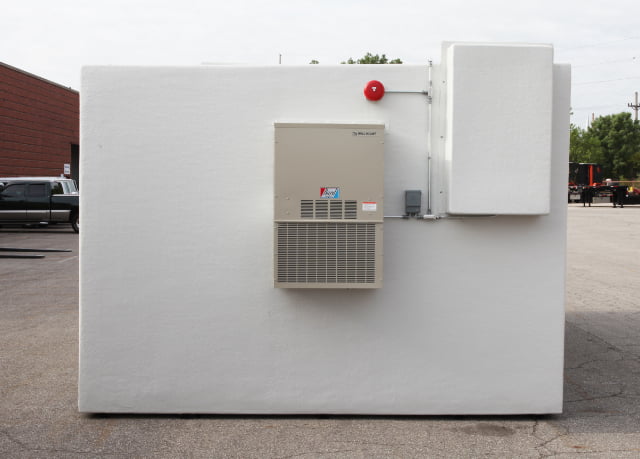If you’ve ever worked with or are familiar with hazardous materials, then you understand the extreme importance of responsibly managing and storing these substances. In the cold storage industry, explosion-proof walk in refrigerators, more accurately termed “classified” walk ins, are designed to mitigate risks associated with flammable or combustible goods. But what does “explosion-proof” mean, and how do these specialized units differ from standard walk in units? We’ll tell you everything you need to know.
What exactly does “explosion-proof” mean in the context of walk in refrigerators?
Actually, “explosion-proof” is just a generic term frequently used in our business, however; in the context of walk in freezers, it does not automatically mean a unit is safe for hazardous locations. Instead, these coolers are classified based on specific regulatory designations. At Polar King, we manufacture two types:
Class 1, Division 1 (C1D1)
- Required when hazardous substances are present in ignitable concentrations under normal operating conditions. This classification applies to the interior and, in some cases, the exterior if the refrigeration is installed remotely.
Class 1, Division 2 (C1D2)
- Used when hazardous substances are not typically present in sufficient quantities to be explosive during normal operations but could become hazardous under certain conditions. This designation ensures that even in the event of leaks or system malfunctions, the cooler remains safe.
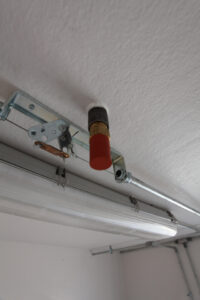
Flammable vs. explosion-proof refrigerator
What if you need a refrigerator to store flammable materials but do not have an environment where flammable vapors or gases are present outside the unit? In this case, a flammable material storage refrigerator is the appropriate choice.
Is there a difference between this type of unit and an explosion-proof refrigerator?
Yes.
Although flammable material storage refrigerators and explosion-proof refrigerators share a key safety feature, a spark-free interior, the primary distinction lies in their external design. Flammable storage units focus on preventing internal ignition, making them suitable for storing volatile substances in controlled environments. However, explosion-proof units go a step further by also eliminating external sparking components, ensuring they won’t ignite hazardous vapors or gases in the surrounding area.
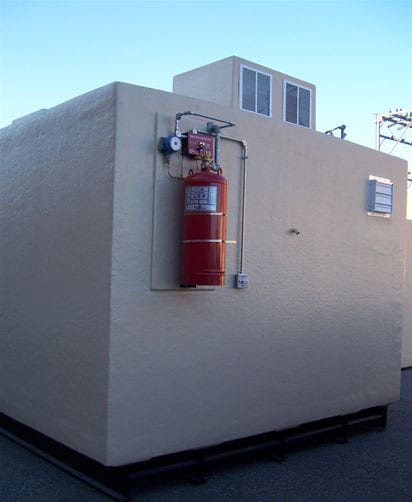
Fireproof vs. explosion-proof: what’s the difference?
When people ask for a “fireproof” walk in cooler, they usually mean a fire-resistant enclosure, often called a “fire rated cooler” in project specifications. Fire resistance describes how the box resists the spread of fire for a defined period, and it is driven by construction details such as insulated panels, facings, doors, and penetrations. The intent is building and human safety, to help protect adjacent spaces and egress routes. It does not address ignition sources in a hazardous atmosphere around the unit.
“Explosion-proof” applies when a walk in cooler or walk in freezer is installed in an area where flammable vapors or gases may be present. The focus is on the electrical system and related elements, including fixtures, sensors, wiring methods, and penetrations that are designed and labeled so they will not ignite the surrounding atmosphere (for example, C1D1 or C1D2). Choose fire resistance when you need enclosure performance for building and fire code compliance, and choose explosion-proof when you need ignition control in a hazardous location. You cannot substitute one for the other. Some projects require both, such as a fire rated enclosure with explosion-proof lighting and controls, and the Authority Having Jurisdiction or “AHJ” (the official who interprets/enforces the adopted code for a given job) makes the final call. Our team can help coordinate the right documentation, labels, and submittals for approval.
What industries require explosion proof walk in freezers?
Manufacturing is the most common application which can include the chemical, aerospace and test chamber industries, among others. Basically, any industry where hazardous environments exist.
Types of substances or products typically stored in an explosion-proof walk in refrigerator can include:
- Chemicals with low flash points
- Volatile solvents and gases
- Certain pharmaceutical compounds
- Combustible liquids requiring precise temperature control
Determining the need for a classified walk in unit
If you own or operate a business that requires storing chemicals or combustible substances in a hazardous environment, you should first assess whether the materials pose a fire/explosion risk. If you’ve determined these materials do in fact have a low flash point, then a classified explosion-proof walk in freezer is a necessity. Risk assessments, sometimes conducted with input from insurance companies, can help businesses determine appropriate storage solutions.
In contrast, if you only need basic refrigeration for food, beverages or non-hazardous materials, a standard walk in cooler is the more practical choice. If you are storing flammable materials inside, but don’t have a hazardous environment outside the unit, then a flammable materials storage refrigerator is your choice.
To reiterate, using an explosion-proof refrigerator in a non-hazardous environment is unnecessary.
Explosion-proof walk in freezers vs. standard walk in units
As mentioned above, standard walk in coolers are designed for general commercial and industrial refrigeration needs, while an explosion-proof walk in freezer is engineered to prevent ignition in hazardous locations where flammable materials may be present.
In terms of design and function, explosion-proof walk ins require all electrical components to be explosion-proof and meet hazardous location ratings. Standard walk in coolers use conventional wiring and fixtures. Here are some additional key differences between the two types of walk in units:
Standard walk in cooler
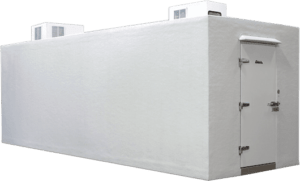
- Refrigeration system: conventional
- Enclosure & materials: basic insulation and standard materials
- Safety features: no specialized hazard protection
- Regulatory compliance: general commercial building codes
Explosion-proof walk in refrigerator
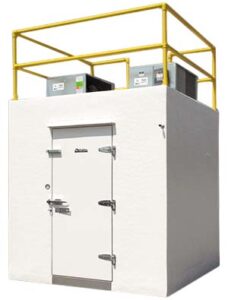
- Refrigeration system: must comply with hazardous area classifications, may require remote installation
- Enclosure & materials: heavy-duty enclosures, sealed wiring, fire-resistant materials
- Safety features: LEL (Lower Explosive Limit) and O₂ sensors, alarms, fire suppression, grounding rods
- Regulatory compliance: must meet NFPA, NEC (National Electrical Code), and OSHA hazardous location standards and enclosures must be designed to contain and withstand internal explosions, preventing the release of flames or sparks to the external atmosphere.
NFPA, NEC, and OSHA’s relationship to explosion-proof walk-ins
NFPA provides the model safety codes used by Authorities Having Jurisdiction. The core reference is NFPA 70 (the National Electrical Code), which defines hazardous classified locations and prescribes how to select and install electrical equipment. The design team and AHJ establish the area classification for the project, such as Class I, Division 1 or Division 2 or the equivalent Zones, often using NFPA 497 for gases and NFPA 499 for dusts. Once the classification is set, an explosion-proof walk in cooler or walk in freezer uses listed components with the correct group and temperature code, and follows wiring methods and sealing requirements in NEC Articles 500 through 505. This covers light fixtures, switches, controls, conduit seals and more.
OSHA governs the workplace side. Under 29 CFR 1910.307, employers must use equipment that is approved for the classified location and installed in accordance with the NEC. In practice this means third-party listings or approvals from a Nationally Recognized Testing Laboratory such as UL, CSA, or FM and labels that match the project classification. Typical submittals include cut sheets, wiring diagrams, and installation details for seals and gaskets, with final acceptance by the AHJ.
Does the installation process differ from that of a standard walk in freezer?
Installation of an explosion-proof walk in freezer is generally similar to that of standard units unless they are located within a classified hazardous area. Maintenance requirements are also similar but should include regular risk assessments to ensure ongoing compliance. As mentioned, many businesses involve insurance providers in these assessments to mitigate liability.
Choosing the right manufacturer
Selecting a manufacturer for an explosion-proof walk in refrigerator is an important decision. Businesses should seek a company with a proven history of successfully delivering classified storage solutions without failures in the field. Experience, compliance expertise and industry reputation should be key considerations.
Polar King specializes in classified walk in freezers, ensuring compliance with regulatory requirements and safety standards. Our experienced team will help you select the right solution for your hazardous storage needs, offering Class 1, 2, and 3, as well as Division 1 and 2 ratings. Whether you need a standard explosion-proof unit or a customized freezer, we have you covered. Contact us to learn more!

